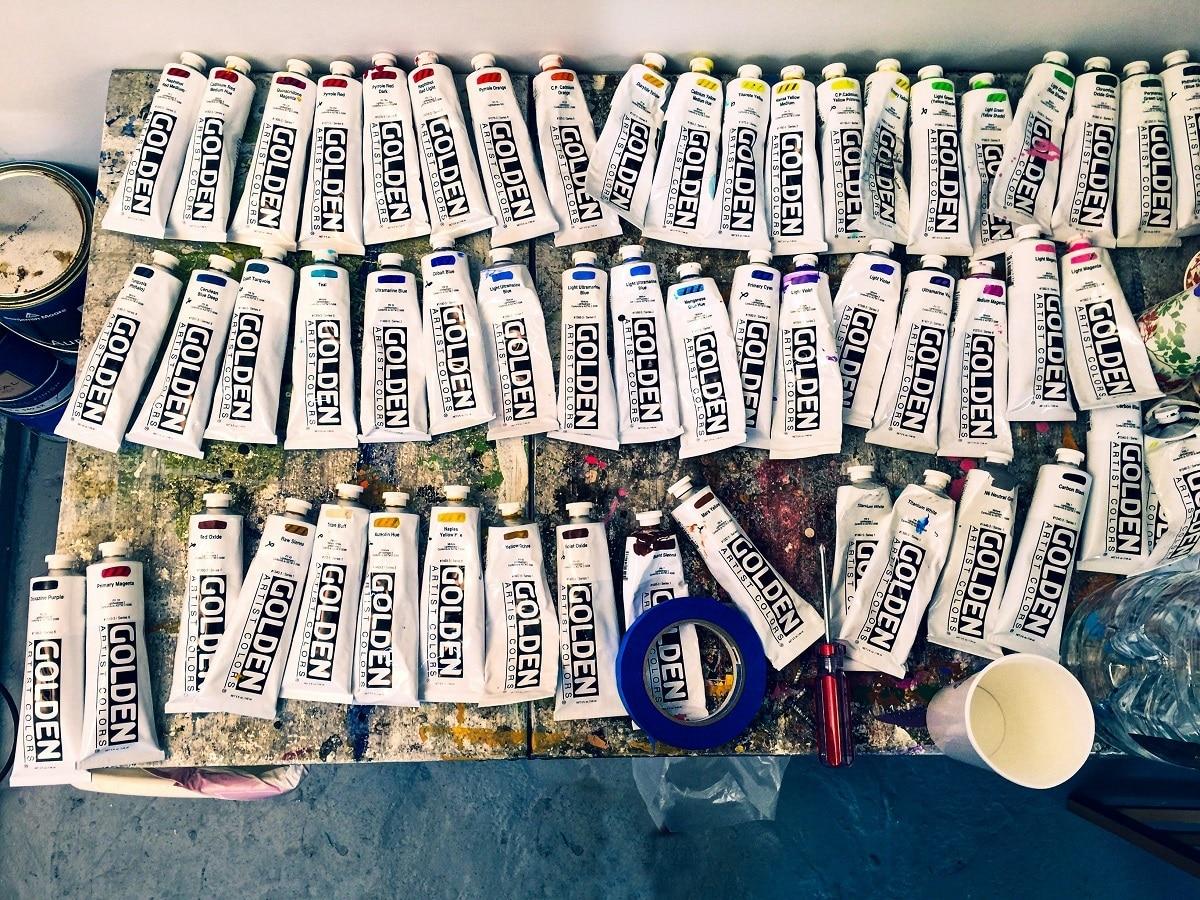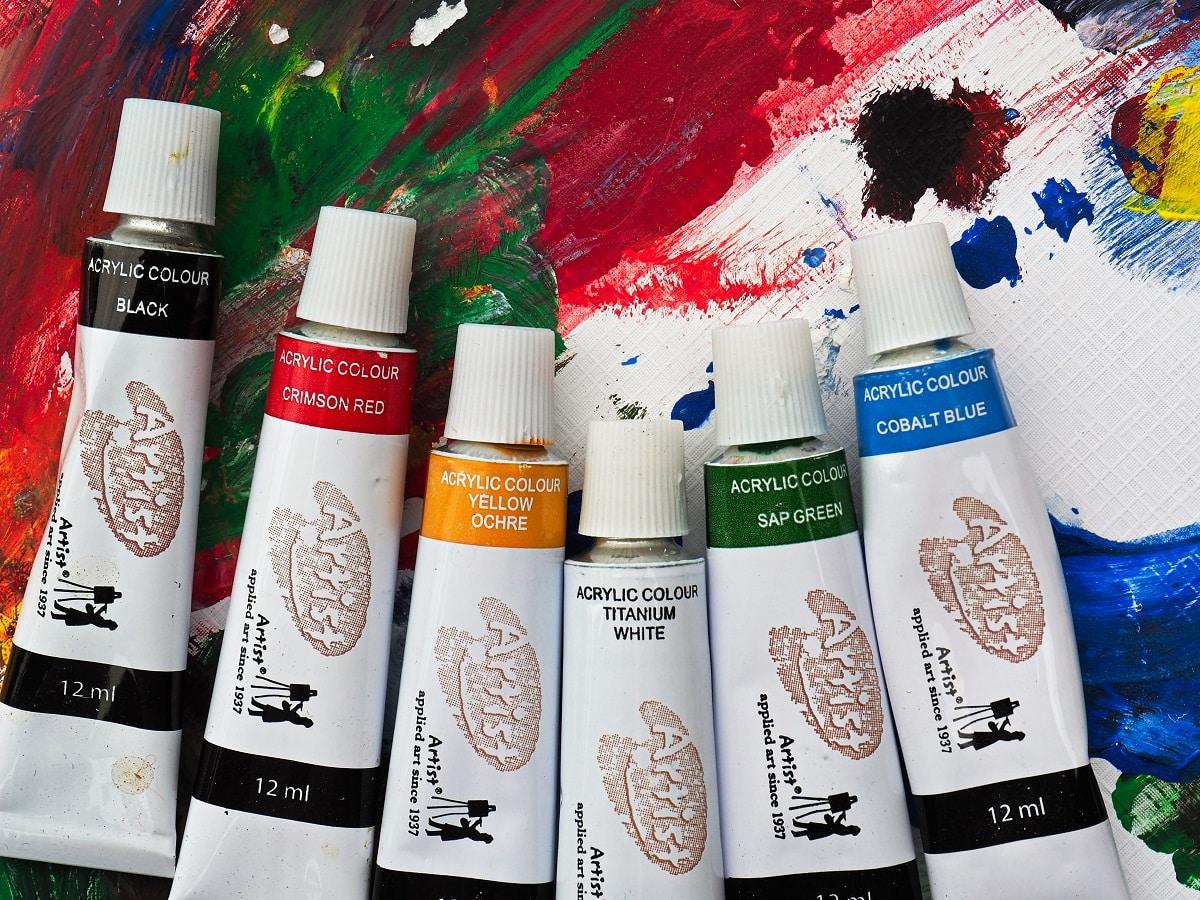You’ll need to give your house a good ol’ touch-up once in a while and make it feel new again!
Now, you have your brushes, stepladder, and working overalls at the ready. All that’s left is to choose which paint to use. But choosing the kind of paint to use can be a daunting task. There are a plethora of brands and types of paint that are even more varied. Hence, finding the one that works for your purposes can be like looking for a needle in a haystack.
So, you have the best brushes for acrylic painting, but you’re wondering “can acrylic paint be used on metal?” “Does acrylic paint expire, or is it durable enough to stick around for a long time?” We have just the information you need.
Acrylic Paint: An Overview

Acrylic paint is a chemical-based substance made by suspending pigment in a polymer solution and acrylic resin. It’s a water-soluble paint that becomes water-resistant when dry, and mixing it with different solvents provides a variety of textures to the finished result.
Besides it can be used on most primed surfaces without any issues.
Acrylic paint can also resist harsh weather and UV rays quite well. Since it dries pretty quickly and works best when used in smaller areas, it’s the paint of choice for artists.
Keep in mind that it does not spread well and requires a notably high amount to cover a large surface. Combined with its relatively large expense and thicker consistency, it is usually not used in bulk. Its use is even more limited by higher VOC levels, which may result in the paint expelling harmful fumes. However, it is very elastic and durable, so acrylic paint is often mixed with other solvents and gels to maximize its benefits.
Latex Paint: An Overview
Latex paint is a water based emulsion. Like its competitor, it is also derived from acrylic resins. It is a water-soluble paint that allows water to pass through even when dry.
Moreover, latex paints are inherently less toxic because they are water based. There is no noticeable odor, and you’ll find that cleaning up after a paint job is a cinch.
The thinner consistency of latex paint provides excellent coverage in just a few coats. It’s widely available and can be purchased in a color of your choice.
Latex paints are a bit less impactful on the environment and your health, thanks to their low VOC levels. This makes them a very effective alternative to acrylic paints when it comes to home improvement. As we move forward, latex paints look to challenge conventional paints and perhaps replace them eventually.
Best suited for both interior and exterior surfaces, latex paints offer a nice finish without burdening your wallet. However, there are some downsides to using latex paint, namely the durability. Also, it doesn’t last very long and can chip away after some time, especially if the paint is of low quality.
Acrylic Vs Latex Paint

Acrylic and latex paints are two of the most common types on the market. The question here is: where do these paints excel? So, let’s find out their strengths and weaknesses.
1. Chemical Composition
As mentioned earlier, acrylic paint is a chemical-based paint that essentially became the replacement for oil based paints. In short, it’s formed by suspending pigment in emulsion and plasticizers. And the exact ingredients may vary depending on the types of acrylic paints created for specific uses.
When mixed with water, acrylic gels, or other solvents, acrylic paint gains unique attributes that different kinds like oil and latex cannot replicate. This flexibility eventually resulted in oil-based paints seeing a decline on the market some 15 years ago.
Most latex paints consist of acrylic resins, titanium dioxide and limestone. And when these ingredients are mixed, they form a water-soluble emulsion that will give you different gloss finishes. Thanks to this base, the paint dries quickly.
Nowadays, latex paints are derived from a synthetic polymer rather than rubber tree sap. The result is an elastic finish permeable enough for moisture to escape.
2. Durability
Acrylic paint offers unparalleled durability and elasticity. It resists wear and tear well and repels water once dry. This makes acrylic an excellent pick for both interior and exterior painting purposes, including painting outdoor furniture.
Although latex paint is durable enough, it doesn’t hold up as well in harsh weather like its acrylic counterpart. In some time, you will notice chips and cracks appear on the surface, signaling that the time to repaint is near. Though it can hold up well in exteriors, it’s better suited for interiors and wooden furniture.
3. Versatility
Acrylic paint can be used on wood and masonry quite easily. Where it stands out, though, is with metal and plastic surfaces. It sticks to these surfaces without compromising durability.
Latex paint excels when applied to wood and masonry. Although you need to prime the surfaces, the result is well worth the extra work.
However, latex won’t get you the finish acrylic can if metal or plastic materials are involved.
4. Coverage
Acrylic paint is thicker and dries quickly. It has relatively limited coverage and may leave an uneven finish. But this also means that acrylic paint needs fewer coats to finish the job.
Latex paint beats acrylic out entirely in terms of coverage. It is a water-based paint and has no trouble spreading as far as it must. The finish it offers is also glossier and more varied. Latex paints require a smooth surface for applications as well, since it may peel off if the surface has imperfections.
5. Ease Of Cleaning
You’ll need a paint stripper. No other way around it; acrylic’s durability works against it when it comes to cleaning up afterward. Just soap and water won’t cut it with acrylic paint.
Latex paint can be cleaned up quickly, be it from surfaces or hands. The most effort you’ll need to put into cleaning surfaces is to rub some detergent into a rag. However, you won’t need much to remove it from your skin- just warm soapy water.
6. Health Impacts
Although acrylic paint is generally safe to use, it may exude toxic fumes. You’ll need protection against it, preferably a mask, since it may have trace amounts of ammonia. Certain types of acrylic paints also contain formaldehyde.
Latex paints come with very few health risks. There are no fumes, and you won’t need a mask while painting. That said, it is advisable to use gloves and general safety gear while painting, as latex paint may cause mild irritation to the skin.
7. Environmental Impacts
Acrylic paint contains plasticizers, making it hazardous to the environment. Its chemical base may be toxic to aquatic life if released into a water stream. It’s not biodegradable either, so any residues must be disposed of accordingly.
Latex paint, on the other hand, is relatively safer for the environment. It can be disposed of, and the cans recycled without much prep. Regardless, it would be wise to use the paint with great care.
8. Availability
The availability of acrylic paints is, unfortunately, limited. This is because temperature and storage conditions have a tangible effect on the paint’s quality. It is also difficult to obtain certain pigments, making them more expensive.
Latex paint is quite popular and can be found in any home improvement or paint store. It’s the most common of them all as it is a fantastic gateway to painting for everyone.
9. Cost
Acrylic paints usually cost more as some pigments used in their making aren’t readily available. This also leans into their unavailability, since you’ll have to search for it on the market.
Latex paints are an affordable, accessible option since they can be produced with minimal effort. Because of this, you can find latex paints in any home improvement or paint store, boasting a large variety of colors.
10. Weather Resistance
Acrylic house paints are some of the most durable painting media around. This is primarily owed to their chemical base. They are, in essence, plastic and plastic doesn’t exactly degrade under rainfall or the crisp morning sun.
Exterior latex paints have decent longevity, but they will show signs of age inevitably. In other words, latex paints are also durable, simply not as durable.
When it comes to UV ray resistance, Acrylic paint will offer higher resistance when compared to latex paint. But that’s not to say latex paint is lacking in the department in any case.
The resistances offered by either will last you a good while. Acrylic simply gets it perfectly right.
11. Color Variety
You’ll find yourself limited to fewer shades when using acrylic paint. Mixing different shades to get the one you want consistently can be tricky. Your preferred color may not be available in stores at all.
Then there’s also the issue of acrylic paint becoming darker upon drying. This property of the paint may throw a wrench in your plans and you may end up with a color that is significantly different from the one you wanted.
On the other hand, since latex paint is so widely available, you’ll have a much easier time blending in different tones and making the color you desire. More often than not, you’ll find your favored shade in-store with no issues. Latex paint is consistent with its colors, with no drawbacks to speak of.
The Best Of Both Worlds: Acrylic Latex Paint
Both paints are water-soluble and so, they mix very well. This fusion of acrylic and latex paint takes the positives of both sides for a more consistent result. However, your experience with the acrylic latex paint mixture may vary depending on the proportions.
What Acrylic Latex Paint Brings To The Table
The mixture is water-based and so, it inherits nearly all of the positives of latex paint. It is odorless and requires minimal protection during application. The amalgamation can spread far and wide and dries quickly, making it ideal for interior and exterior applications. Acrylic latex paint is easy to clean, requires little-to-no prep time, and is easy to maintain.
With acrylic latex paint, you’ll observe minimal chipping or loss of durability. It is as resilient as acrylic paint and can last a very long time before needing a fresh coat. The paint retains much of its acrylic parent’s characteristics, making it a superb and versatile paint.
Acrylic latex paint can achieve a wide variety of finishes, ranging from a glossy look to a textured one. It dries within a few hours, so you can apply a second coat fairly quickly and finish the task in a timely fashion.
By using acrylic latex paint, you’ll have the adhesion and flexibility of acrylic paint with the odorless and smooth finish of latex paint.
What Sets Acrylic Latex Paint Back
Acrylic latex paints need a primer for best results, a trait inherited from latex paints. These can’t simply be applied anywhere, much like its latex parent. And like their acrylic counterparts, they are costly.
The thing is, acrylic latex paints aren’t always available to purchase, and their mixed properties can be inconsistent, depending on the paints used. So, it may be preferable to use acrylic or latex paint instead, especially if you don’t have much time to spare.
Though expensive, the resulting amalgamation is a superb alternative to either and overcomes their shortcomings without a hitch.
Difference Between Acrylic And Latex Paint Frequently Asked Questions ?
How does the chemical composition of the paint’s performance?
Chemical composition defines the paint’s properties. Acrylic paints have different ‘grades’ where the paint is formulated for various uses, such as art, interior, and exterior painting, furniture painting, etc. These grades include artist acrylics and student acrylics, both of which have entirely different degrees of manipulation and characteristics.
Latex paint, though made from a synthetic polymer as opposed to the sap of rubber tree, is generally more straightforward to handle than acrylic. Plus, it’s easier to wash, apply, and repaint if the need arises. Before application, the surface has to be prepared with a primer, which may limit the effectiveness of the paint, so you may have to apply multiple layers.
All wall paints contain VOCs, or Volatile Organic Compounds. These are carbon-based chemicals that turn into fumes and can harm your health as well as the environment. Lower VOC levels mean that the paint will let out a smaller amount of fumes. Latex paints often have lower VOC levels, while acrylic has a modest amount, making it suitable for painting walls.
Which is better, acrylic or oil paint?
Primarily, the difference that sets them apart is the drying time. The time it takes for oil paints to dry is orders of magnitude higher than that of acrylic paint.
For artists, this may be preferable for the exceptional variety of textures this may lead to, but when it comes to houses, a lot can happen overnight. For this reason, oil based paints have declined in the past 10-15 years. Acrylic paint is a much faster and more reliable painting medium.
How long can acrylic and latex paint be stored?
Latex paint can last up to 10 years if stored correctly, while acrylic paint can be stored for seven years or less.
When stored properly, these paints will serve you for a long time. However, the chemical composition of a paint will affect its longevity significantly. There’s a good chance of your paint lasting longer than the time range specified above.
Which paint will stick to surfaces better?
Acrylic paint is the best in the business when it comes to adhesion. Its chemical components allow it to perform as well as it does without any trouble whatsoever. As with other categories of comparison, latex paint will also be a fantastic second option to acrylic paint.
If you’re painting metal, you’d be better off using acrylic paint instead, as it has better adhesion across the board.

Difference Between Acrylic And Latex Paint Conclusion
Broadly speaking, acrylic paints last longer, dry quickly, offer better elasticity, and have a better range of applications. However, when considering the practicality of either, you’ll conclude that latex paints are better suited for general painting purposes due to their spread area and cost-effectiveness.
In any case, you can’t go wrong with choosing either, as it all comes down to what your preferred paint is. If your priorities lay with efficiency, health, and environmental friendliness, latex paint is the way to go. For your painting finish to be invincible, consider choosing acrylic paint.
With that, it’s time for us to say goodbye, but we will see you another day. Take care!


